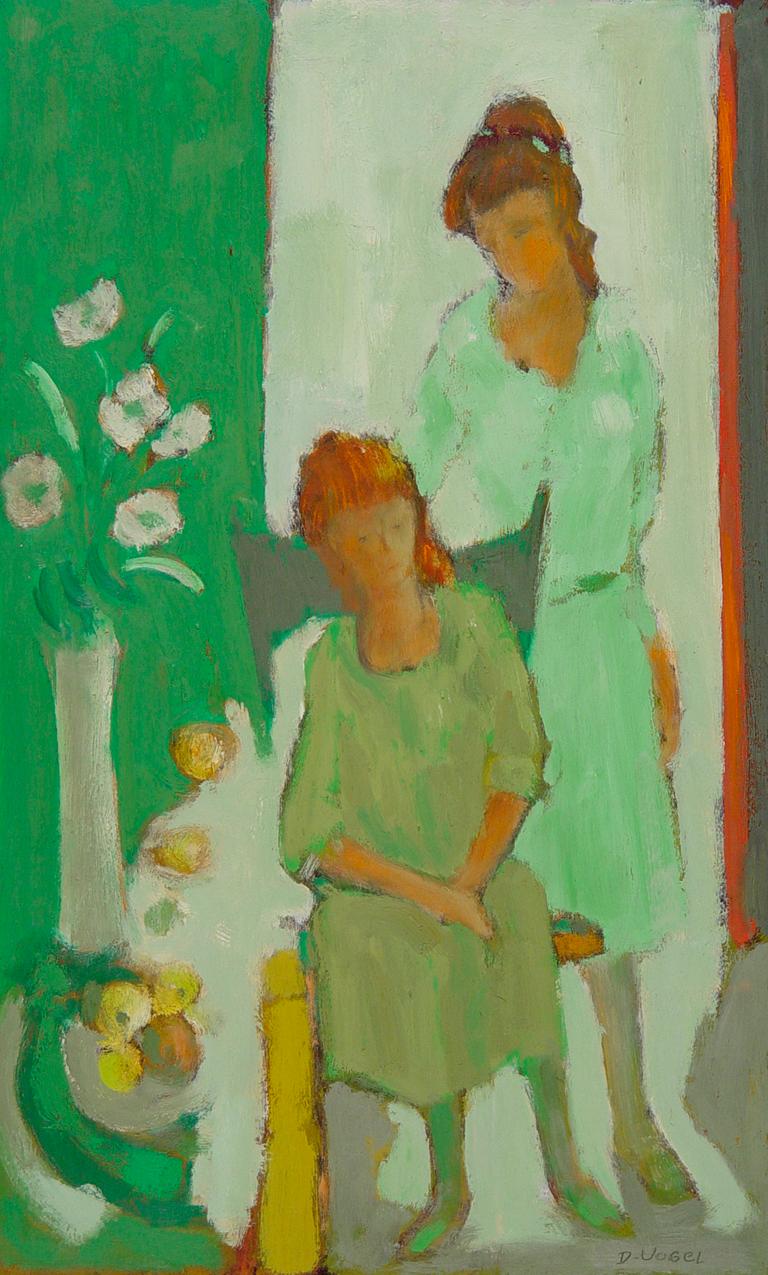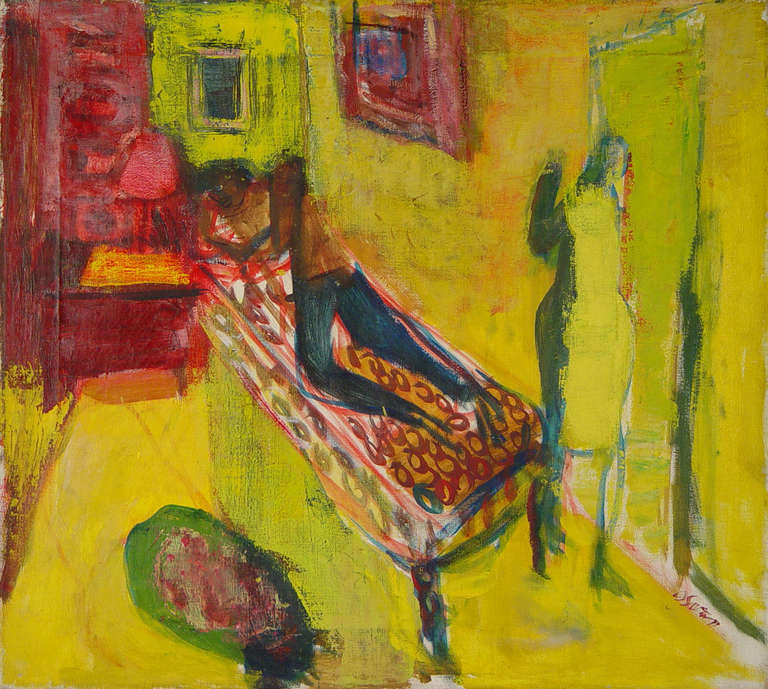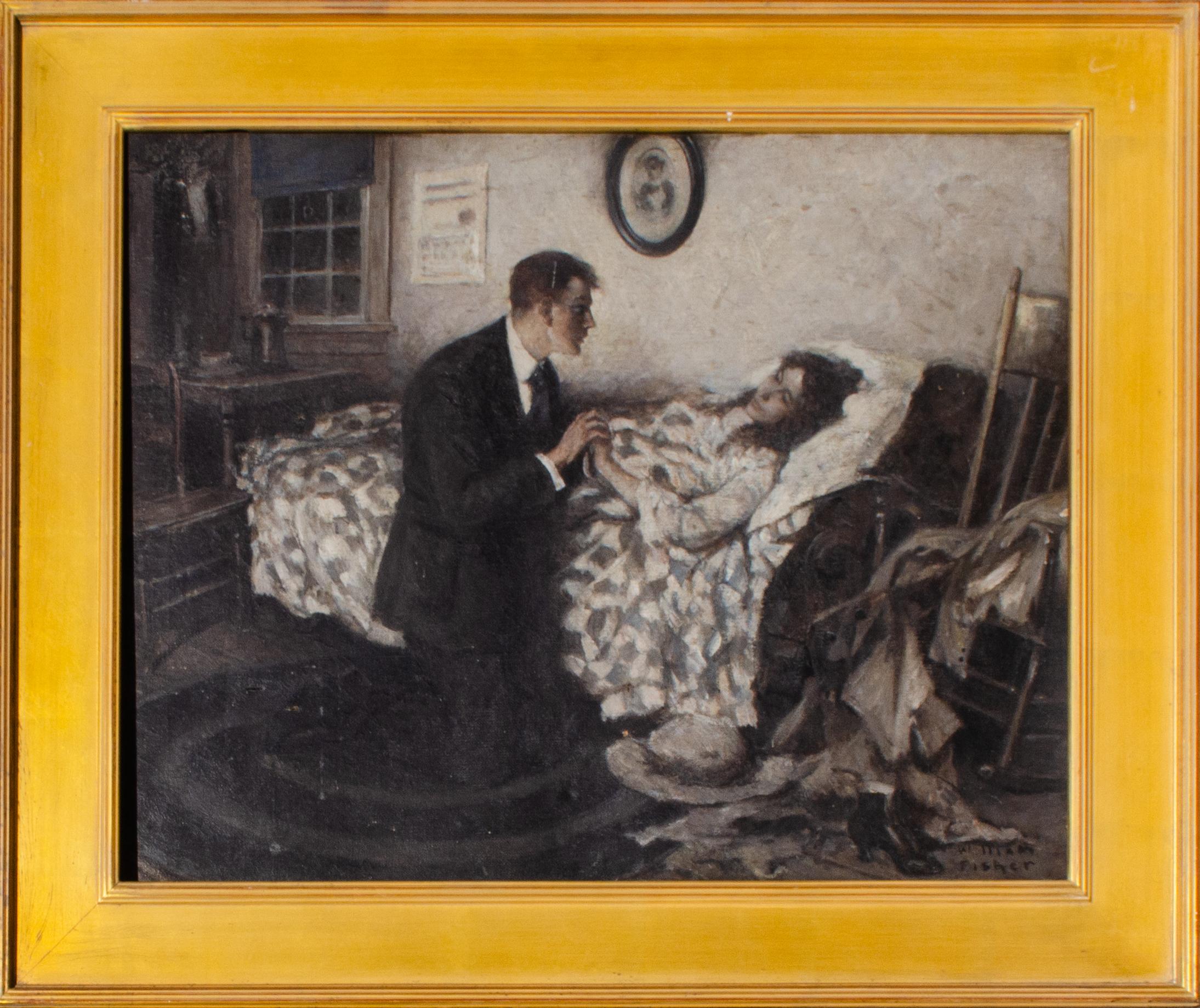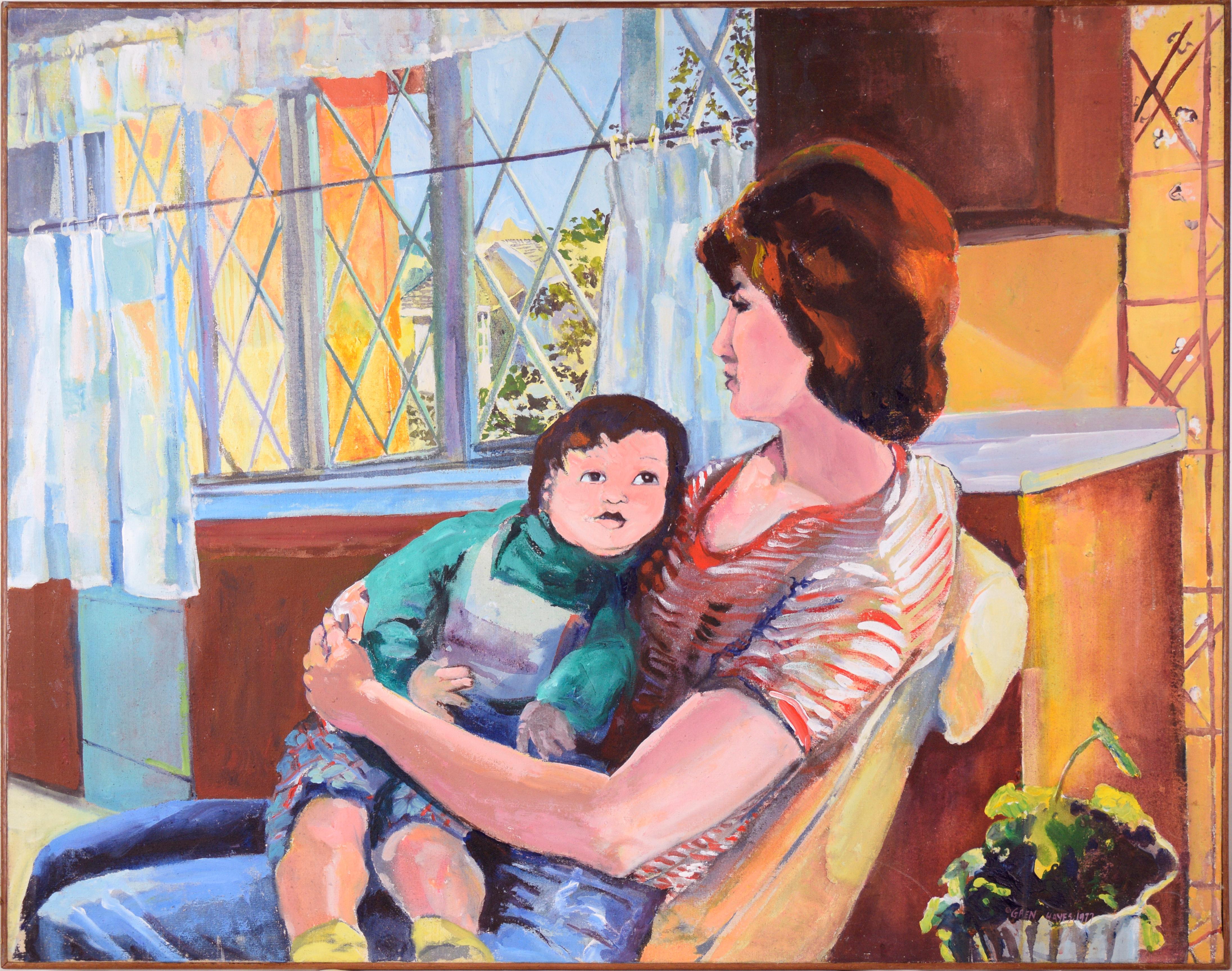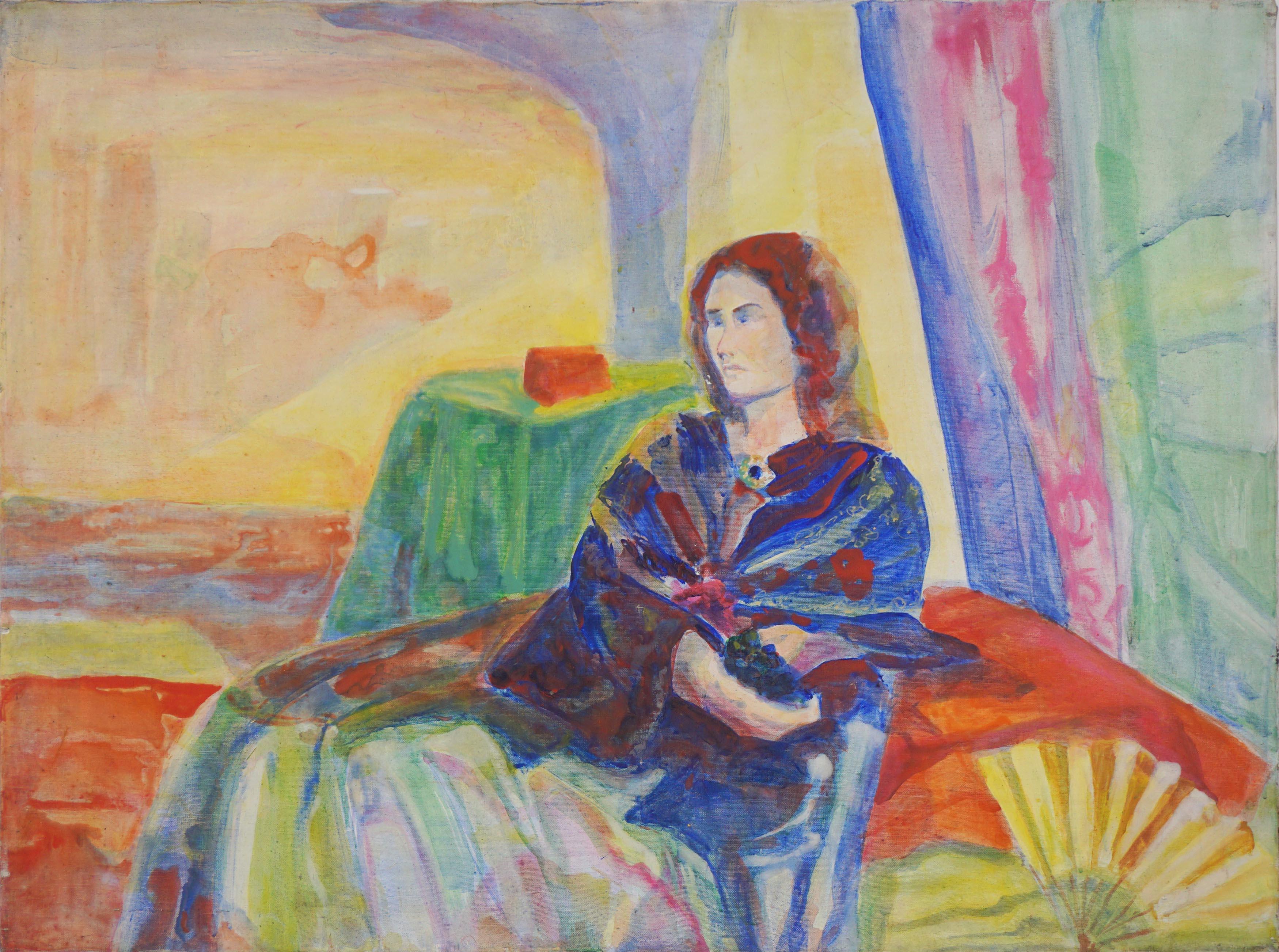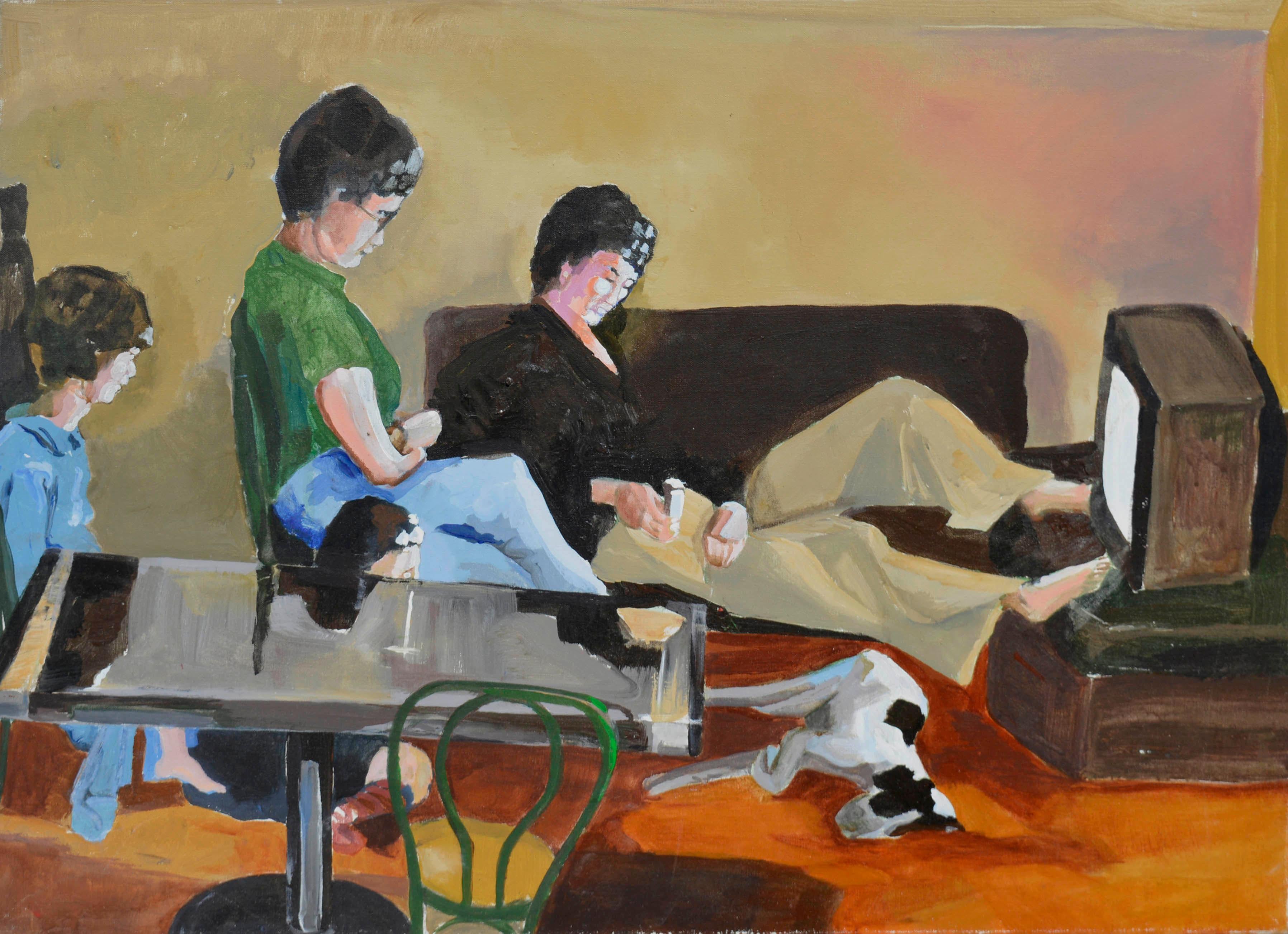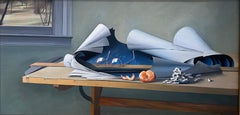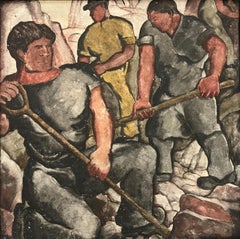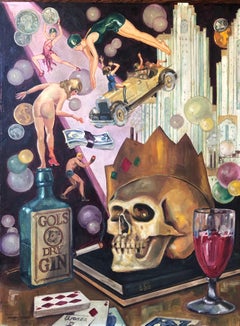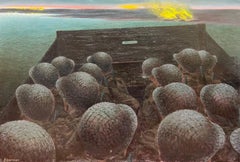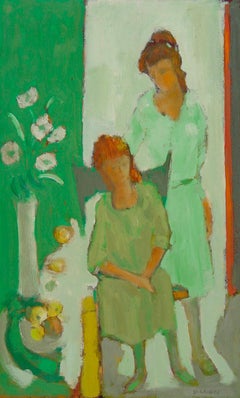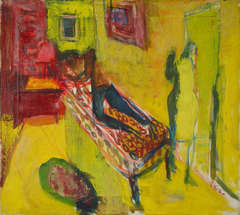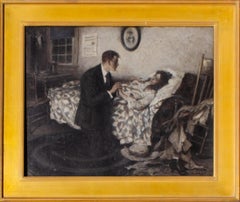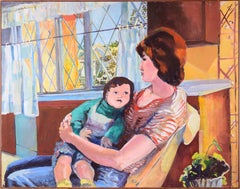Items Similar to San Pedro Post Office: History of Writing Mural South, Preliminary Mural Study
Want more images or videos?
Request additional images or videos from the seller
1 of 5
Edward BibermanSan Pedro Post Office: History of Writing Mural South, Preliminary Mural Studyc. 1936-7
c. 1936-7
About the Item
This mural study is part of our exhibition America Coast to Coast: Artists of the 1930s
San Pedro Post Office: History of Writing Mural South, Preliminary Mural Maquette right panel, 1936-7 mixed media on paper mounted on masonite, 20 x 41 inches (image), 30 x 52 inches (framed); exhibited in Lost Horizons: Mural Dreams of Edward Biberman, Los Angeles County Museum of Art at SPARC's Duron Gallery from May 31 to August 29, 2014; illustrated in i) the catalog for the foregoing p. 22; and ii) (film) Kaufman, Jeffrey, Brush with Life: The Art of Being Edward Biberman, 2007, (DVD release 2010), 85 minutes; provenance estate of the artist; presented in newer frame from the 2014 LACMA/SPARC exhibition
About the Painting
Even before the creation of the WPA and the Treasury Department Section of Fine Arts, Biberman was known as a mural painter, having been selected for inclusion in one of the Museum of Modern Art’s early exhibitions in 1932, Murals by American Painters and Photographers. Around the same time, he also joined the National Society of Mural Painters. While in New York, Biberman lectured on muralism, taught classes on mural techniques and knew, admired, and drew lessons from Los Tres Grandes, the Mexican muralists, Orozco, Rivera, and Siqueiros. By his own reckoning, Biberman competed for seven or eight Federal Government mural projects during the 1930s and early 1940s. In addition to the San Pedro Post Office for which the present works were completed, Biberman submitted designs for the Rincon Annex Post Office (San Francisco), Department of the Interior Building (Washington, DC), the Recorder of Deeds Building (Washington, DC), and the St. Louis Post Office (St. Louis, Missouri), as well as projects in New Jersey and Dallas, Texas. Although Biberman did not win these competitions, he was awarded three Federal Government mural commissions based on being the runner up in several prior efforts. Biberman also served as a member of the jury for the national competition for the Social Security Building in Washington DC where he was able to reconnect with leaders of the Treasury Section of Fine Arts, including Edward Bruce, Edward Beatty Rowan, George Biddle, Holger Cahill and Forbes Watson. Biberman’s completed projects were a wall mural showcasing the history of Los Angeles for the Federal Building in Los Angeles, a ceiling mural for the same building depicting the contributions of four ethnic groups to the development of California, and his best-known mural, Abbott Kinney and the Story of Venice, for the Venice Post Office.
In October, 1936, the Treasury Department Section of Fine Arts announced the competition for the San Pedro California Post Office mural project. The request for submissions noted that the winning artist would receive the handsome sum of $4,900 for the 74-foot long mural. For his entry, Biberman explored the global history of written communication from message sticks through the printing press. In addition to his artistic skills, Biberman was a proficient writer and even better speaker. Words mattered deeply, so Biberman's selection of subject matter is unsurprising, as is his depictions of the contributions of earlier cultures from around the world. Native American peoples had played important parts in his completed mural for the Los Angeles Federal Building, as well as his submissions for the Department of the Interior Building and the Rincon Annex Post Office in San Francisco. Biberman's depiction of less well known forms of written communication such as marked pebbles likely was the result of his interest in historical research and his desire to deeply immerse himself in his mural submissions. "I got very excited by the work" Biberman recalled, "the research, let me say, proved to be one of the most fruitful areas of all of these jobs." Biberman was one of seventy-seven artists to submit designs and his friend and fellow Angelino, Fletcher Martin, won the commission for his designs portraying the history of mail delivery, which can still be seen today.
The Los Angeles County Museum of Art (LACMA), in cooperation with SPAC, hosted a 2014 retrospective of Biberman’s mural-related art at the Duron Gallery, which included all of Biberman's existing designs for the San Pedro Post Office, including this work. This show ran concurrently with LACMA’s other exhibition, Edward Biberman, Abbot Kinney and the Story of Venice, where the Abbott Kinney mural was displayed.
About the Artist
Edward Biberman was born in Philadelphia, the son of Ukrainian Jewish immigrants. His artistic career started at the Pennsylvania Academy of Fine Arts followed by three years of study in Paris, where he associated closely with Calder and Noguchi and exhibited at the Salon d'Automne, Grand Palais, in 1927 and the Salon des Independents in 1929. Upon his return to the United States, Biberman spent time in New York City, where he showed at many of the city’s premier galleries and museums. His works were selected for several of the Museum of Modern Art’s early exhibitions of American artists, including 46 Painters and Sculptors Under the Age of 35 (1930) and Murals by American Painters and Photographers (1932). Hoping to escape the pressures of the New York art world, Biberman moved to Los Angeles in 1936 where he could be close to his family, including his film director brother, Herbert Biberman, and his sister-in-law, the Academy Award winning actress, Gale Sondergaard.
During the course of his long career, Biberman showed at the Salon d’Automne (Paris); Whitney Museum; Metropolitan Museum of Art, Museum of Modern Art, Corcoran Gallery, Los Angeles County Museum of Art (LACMA) and dozens of other museums and galleries across the US and in Europe. Biberman completed three murals for public works projects, including his work Abbot Kinney and the Story of Venice for the Venice Post Office, which was installed for six months at LACMA in 2014. His works are in the permanent collections of more than a dozen museums, including the National Portrait Gallery (of the Smithsonian Institution), Los Angeles County Museum of Art, Museum of Fine Arts, Houston, Butler Institute of American Art, and Pennsylvania Academy of Fine Arts. Several books are dedicated to Biberman’s art, as is a feature length documentary, Brush with Life: The Art of Being Edward Biberman (2007). Biberman’s art has undergone a resurgence of popularity during the past fifteen years with four solo or focused exhibitions, Edward Biberman Revisited (2009), Edward Biberman (2011-12), Lost Horizons: Mural Dreams of Edward Biberman (2014) and Edward Biberman, Abbot Kinney and the Story of Venice (2014), and representation in a number of other exhibitions, such as To Make a World: George Ault and 1940s America at the Smithsonian Institution and other institutions (2011), Pacific Standard Time (2012), Contraption: Rediscovering California Jewish Artists (2018),Black American Portraits (2021) at LACMA, Encounters in American Realism (2022) at The Westmoreland Museum of American Art and Art for the People WPA Paintings from the Dijkstra Collection (2023) at the Crocker Art Museum (Sacramento, CA), Oceanside Museum o f Art (Oceanside, CA) and The Huntington Library, Art Museum and Botanical Gardens (San Marino, CA).
Biberman’s brand of modernism can fairly be divided into four categories 1) precisionist urban scenes of New York and Southern California which celebrate the creations of humanity; 2) portraits which expose not only the historical context, but also the souls, of his subjects; 3) rural landscapes and still life paintings which portray the beauty of America and its flora; and 4) social realist works which explore the struggles, hopes and shortcomings of our society. Regardless of genre, Biberman had a unique sense of structure and color. His figures are at the same time specific and universal. Taken as a whole, Biberman’s body of work presents the viewer with a compelling and often daring vision of 20th century America and its art.
- Creator:Edward Biberman (1904 - 1986)
- Creation Year:c. 1936-7
- Dimensions:Height: 20 in (50.8 cm)Width: 41 in (104.14 cm)Depth: 1 in (2.54 cm)
- More Editions & Sizes:20 x 41Price: $27,500
- Medium:
- Movement & Style:
- Period:
- Condition:
- Gallery Location:Los Angeles, CA
- Reference Number:1stDibs: LU1859213056692
About the Seller
5.0
Gold Seller
Premium sellers maintaining a 4.3+ rating and 24-hour response times
1stDibs seller since 2022
14 sales on 1stDibs
Typical response time: 16 hours
- ShippingRetrieving quote...Shipping from: Los Angeles, CA
- Return Policy
Authenticity Guarantee
In the unlikely event there’s an issue with an item’s authenticity, contact us within 1 year for a full refund. DetailsMoney-Back Guarantee
If your item is not as described, is damaged in transit, or does not arrive, contact us within 7 days for a full refund. Details24-Hour Cancellation
You have a 24-hour grace period in which to reconsider your purchase, with no questions asked.Vetted Professional Sellers
Our world-class sellers must adhere to strict standards for service and quality, maintaining the integrity of our listings.Price-Match Guarantee
If you find that a seller listed the same item for a lower price elsewhere, we’ll match it.Trusted Global Delivery
Our best-in-class carrier network provides specialized shipping options worldwide, including custom delivery.More From This Seller
View AllUnfinished Problem
Located in Los Angeles, CA
Unfinished Problem, by 1953, oil on canvas, signed lower right, signed and inscribed verso on stretcher “Charles Goeller/1272 Clinton Place, Elizabeth, NJ...
Category
1950s American Modern Interior Paintings
Materials
Canvas, Oil
Quarry Workers
Located in Los Angeles, CA
This painting is part of our exhibition America Coast to Coast: Artists of the 1930s
Quarry Workers, c. 1930s, mixed media on board, unsigned, 24 x 24 inches, possibly exhibited at...
Category
1930s American Modern Figurative Paintings
Materials
Mixed Media
What a Life
Located in Los Angeles, CA
What a Life, c. 1930, mixed media on board, 18 x 24 inches, signed lower left; titled on label; exhibited at The San Francisco Art Association Fifty-Second Annual Exhibition at the P...
Category
1920s American Modern Figurative Paintings
Materials
Mixed Media
The Landing/Dawn Landing
Located in Los Angeles, CA
This painting is part of our exhibition America Coast to Coast: Artists of the 1940s.
The Landing/Dawn Landing, 1944, oil on canvas, signed lower left, 20 x 30, titled verso; exhibited in the Twelfth Annual Exhibition of Trends in Southern California Art at the Foundation of Western Art, Los Angeles, from early November to December 30, 1944 (see Millier, Arthur, Trends Show Attracts Best Southland Art, The Los Angeles Times, part III, p.6, November 4, 1944, illustrated in Edward Biberman, Time and Circumstance: Forty Years of Painting by Edward Biberman, The Ward Ritchie Press, Los Angeles (1968), p. 57, presented in its original frame
The Landing/Dawn Landing is a rare and critically acclaimed example of Edward Biberman's World War II paintings...
Category
1940s American Modern Paintings
Materials
Canvas, Oil
Price Upon Request
Street Cleaners
Located in Los Angeles, CA
This painting is part of our exhibition America Coast to Coast: Artists of the 1930s
Street Cleaners, c. 1940s, oil on canvas, signed lower right, 28 ¾ x 42 inches, Gallery Z...
Category
1940s American Modern Figurative Paintings
Materials
Oil
Price Upon Request
Six O'Clock
Located in Los Angeles, CA
Six O-Clock, c. 1942, oil on canvas, 30 x 20 inches, signed and titled several times verso of frame and stretcher (perhaps by another hand), marked “Rehn” several times on frame (for the Frank K. M. Rehn Galleries in New York City, who represented Craig at the time); Exhibited: 1) 18th Biennial Exhibition of Contemporary American Oil Paintings from March 21 to May 2, 1943 at The Corcoran Gallery of Art in Washington, D.C. #87, original price $450 (per catalog) (exhibition label verso), 2) Craig’s one-man show at the Frank K. M. Rehn Galleries, New York City, from October 26 to November 14, 1942, #10 (original price listed as $350); and 3) Exhibition of thirty paintings sponsored by the Harrisburg Art Association at the State Museum of Pennsylvania in Harrisburg in March, 1944 (concerning this exhibit, Penelope Redd of The Evening News (Harrisburg, Pennsylvania) wrote: “Other paintings that have overtones of superrealism inherent in the subjects include Tom Craig’s California nocturne, ‘Six O’Clock,’ two figures moving through the twilight . . . .” March 6, 1944, p. 13); another label verso from The Museum of Art of Toledo (Ohio): original frame: Provenance includes George Stern Gallery, Los Angeles, CA
About the Painting
Long before Chris Burden’s iconic installation outside of the Los Angeles County Museum of Art, Urban Light, another artist, Tom Craig, made Southern California streetlights the subject of one of his early 1940s paintings. Consisting of dozens of recycled streetlights from the 1920s and 1930s forming a classical colonnade at the museum’s entrance, Burden’s Urban Light has become a symbol of Los Angeles. For Burden, the streetlights represent what constitutes an advanced society, something “safe after dark and beautiful to behold.” It seems that Craig is playing on the same theme in Six O-Clock. Although we see two hunched figures trudging along the sidewalk at the end of a long day, the real stars of this painting are the streetlights which brighten the twilight and silhouette another iconic symbol of Los Angeles, the palm trees in the distance. Mountains in the background and the distant view of a suburban neighborhood join the streetlights and palm trees as classic subject matter for a California Scene painting, but Craig gives us a twist by depicting the scene not as a sun-drenched natural expanse. Rather, Craig uses thin layers of oil paint, mimicking the watercolor technique for which he is most famous, to show us the twinkling beauty of manmade light and the safety it affords. Although Southern California is a land of natural wonders, the interventions of humanity are already everywhere in Los Angeles and as one critic noted, the resulting painting has an air of “superrealism.”
About the Artist
Thomas Theodore Craig was a well-known fixture in the Southern California art scene. He was born in Upland California. Craig graduated with a degree in botany from Pomona College and studied painting at Pamona and the Chouinard Art School with Stanton MacDonald-Wright and Barse Miller among others. He became close friends with fellow artist Milford Zornes...
Category
1940s American Modern Landscape Paintings
Materials
Canvas, Oil
$12,500
You May Also Like
Two Girls in Green
By Donald S. Vogel
Located in Dallas, TX
Donald Vogel’s paintings reflect his interest in seeking beauty in life and in sharing pleasure with his viewers. Vogel entreats us to "rejoice and celebrate each new day, knowing it...
Category
1960s American Modern Figurative Paintings
Materials
Oil, Panel
Interior with Figures
By Arthur Osver
Located in Dallas, TX
Arthur Osver studied at Northwestern University and the Art Institute of Chicago. Osver was awarded the Prix de Rome in 1952. He taught at the Brooklyn Museum Art School, Columbia Un...
Category
1930s American Modern Interior Paintings
Materials
Canvas, Oil
William Fisher Classic American Illustration on Canvas
Located in New York, NY
William Fisher (American, 1891-1985)
Untitled, 20th Century
Oil on canvas/illustration
23 3/4 x 29 3/4 in.
Framed: 31 x 37 1/4 x 1 in.
Signed lower right: William Fisher
William Fis...
Category
20th Century American Modern Figurative Paintings
Materials
Canvas, Oil
"Madam Suburbia #2" (Woman and Child, Sue & Casey) in Oil on Canvas
By Patricia Gren Hayes
Located in Soquel, CA
"Madam Suburbia #2" (Woman and Child, Sue & Casey) in Oil on Canvas
An auburn-haired woman sits in a chair with her young child, by American painter, Patricia Gren Hayes (b. 1932). ...
Category
Mid-20th Century American Modern Figurative Paintings
Materials
Canvas, Oil
Modern Figurative -- Hayley in the Sunroom
By Patricia Gren Hayes
Located in Soquel, CA
Modern interior/figurative painting of red-haired woman "Hayley" seated in sunroom by American painter, Patricia Gren Hayes (b. 1932), Circa 1975.
Signed on verso, "Hayley" written on edge
Provenance: Purchased as part of larger collection of artist's work
Unframed.
Canvas size: 30"H x 440"W.
Patricia Gren Hayes (American, b. 1932) is a Bay Area Figurative & Feminist Art Movement artist who studied at Winnipeg Public Art School in 1950. She received early recognition in Museum and Gallery competitions and exhibitions and was awarded a Special Education in Art recognition by the Winnipeg Museum of Fine Art, and was awarded a scholarship to the Banff College of Fine Art. Further studies were at The University of Manitoba.
She was a Member of Winnipeg Free Press Sketch Club and was a Cartoonist and paste-up for a French-English bi-weekly, in Eastern Canada;
She studied outdoor impressionism in New York in 1960; in 1962, attended The California College of Arts and Crafts, and in 1976 B.A., U.C. Berkeley where she studied under Elmer Bischoff, David Simpson, Joan Brown, Felix Ruvolo, Yolanda Lopez and Vincent Perez.
She started a freelance commercial art business in 1963; copyrighted a National Cartoon, 1976, and served as Exhibition Director for San Francisco Woman Artists Gallery and the San Francisco Museum of Modern Art, 1976-1978. She was a workshop instructor at the San Francisco Woman Artists Gallery, 1977-1985; and was Manager/Owner Stanton Art Gallery, Alameda, CA, 1976-1982.
Solo Exhibitions:
Berkeley Marina, 1974;
Oakland Center for The Visual Arts, "Images of Women", 1979
Group Exhibitions:
Oakland's Dept of Education, 1963, Studio One;
Alameda County Fair, 1975, 1976, 1978;
San Francisco Art Festival, 1969, 1970, 1976, 1977, 1978;
San Francisco Museum of Modern Art, 1976, 1977, 1978;
San Francisco Women Artists Gallery Exhibition, award winner - 1970, 1977, 1978;
Hayward Bay Fair Art Festival, award winner - 1971;
Capricorn Assunder Gallery, 1973;
Oakland Art Festival, 1973, 1974;
Alameda Art Association, 1978;
El Cerrito...
Category
1970s American Modern Figurative Paintings
Materials
Canvas, Oil
"Madam Suburbia -- The New Religion" Vintage Figurative Berkeley School
By Patricia Gren Hayes
Located in Soquel, CA
Evocative and compelling Suburbia scene painting titled "Madam Suburbia...The New Religion" by Patricia Gren-Hayes (American, b. 1932). Signed and titled, dated 1975 on verso and upper edge and noted Ruvolo for Felix Ruvolo (American, 1912 - 1992) art class. Unframed. Size: 39.5"L x 30"H. Purchased direct from the artists estate.
Bay Area Figurative / Bay Area Feminist Art Movement artist, Patricia Gren-Hayes, studied at Winnipeg Public Art School in 1950. She received early recognition in Museum and Gallery competitions and exhibitions and was awarded a Special Education in Art recognition by the Winnipeg Museum of Fine Art, and was awarded a scholarship to the Banff College of Fine Art. Further studies were at The University of Manitoba.
She was a Member of Winnipeg Free Press Sketch Club and was a Cartoonist and paste-up for a French-English bi-weekly, in Eastern Canada;
She studied outdoor impressionism in New York in 1960; in 1962, attended The California College of Arts and Crafts, and in 1976 B.A., U.C. Berkeley where she studied under Elmer Bischoff, David Simpson, Joan Brown, Felix Ruvolo, Yolanda Lopez and Vincent Perez...
Category
1970s American Modern Figurative Paintings
Materials
Canvas, Oil
$2,000 Sale Price
20% Off
Recently Viewed
View AllMore Ways To Browse
San Marino Vintage
Edward Hoper
Up 7 Foot
Framed Vintage Botanical Art
Vintage Film Leader
Vintage Pebble Art
Tre P
1930s Actress
St Louis Federal
Missouri Sculptor
Noguchi 1
Entry Butler
C Fletcher
Social Realism Social Realism Art 1930s And 1940s
Precisionist Painting
George Fletcher
Sumer Martin
Vintage 3 Speakers
